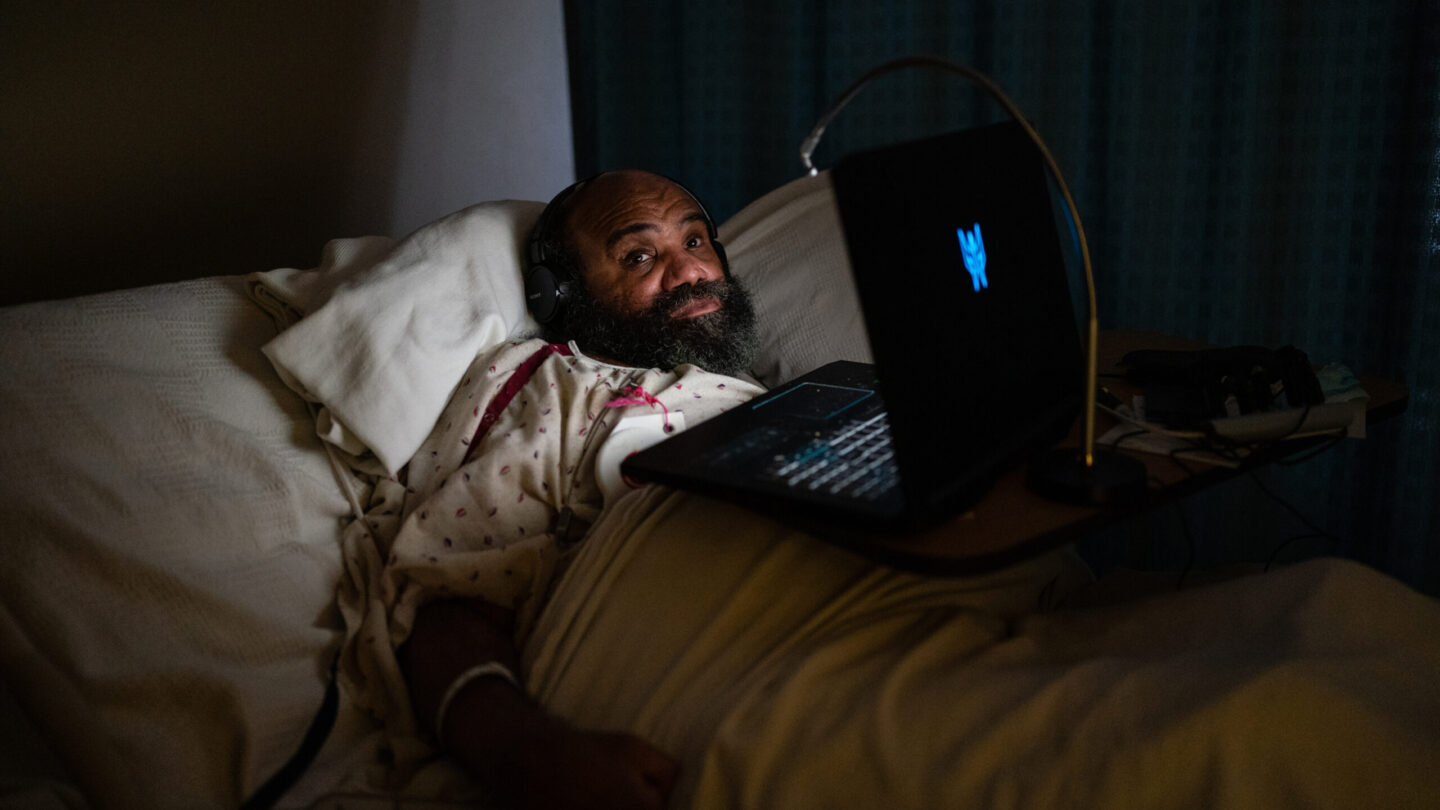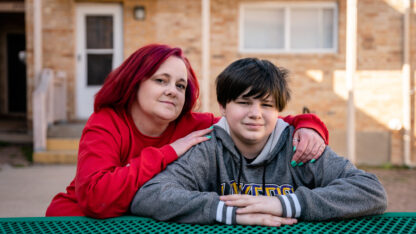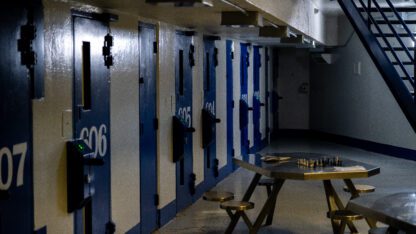A decade after suffering a stroke that forever changed his life, Maurice Miller has good days and bad ones.
On good days, the staff at his nursing home in Takoma Park, Md., can meet all of his basic needs: feeding him, cleaning him, changing his hospital gown, and ensuring that his laptop, which he uses through dictation, is charged and within reach.
On bad days, something goes wrong and it takes a while before someone is available to respond to his call button — sometimes 45 minutes or longer.
“It’s a bad day when I’m in pain, and I’m not going to get relief in a timely fashion,” says Miller, who describes himself as a functional quadriplegic.
It’s also a bad day when he cannot call his 94-year-old mother, because his computer has been pushed out of reach. Or when his roommate is having a crisis of some sort and help does not come immediately. Or when he misses his wheelchair time because there aren’t enough staff to lift him out of bed.
The bad days are more likely to be those when the facility is short-staffed. Lying in bed in his darkened room, Miller usually knows when there are fewer than five nursing assistants tending to the 50 or so residents on his hall. He hears about it from the staff, who apologize for the long waits and ask for patience.
The Biden administration is vowing to improve nursing home care by setting a minimum staffing requirement
Stories like Miller’s — and far worse — have pushed the Biden administration to call for major reforms in nursing homes. Earlier this year, the White House outlined an ambitious plan to improve the safety and quality of nursing home care, first and foremost by establishing a federal minimum staffing requirement for nursing homes funded through Medicare and Medicaid.
“We think it’s really important to set a very specific standard that can be measured against, to really make sure staff is adequate to ensure quality,” says Chiquita Brooks-LaSure, administrator for the Centers for Medicare & Medicaid Services (CMS), the federal agency that regulates and funds most nursing homes in the U.S.
Numerous studies have shown that understaffing nursing homes can harm the health of residents, who suffer more bedsores, more weight loss, more overprescribing of anti-psychotic medications, and — during the pandemic — more COVID-19 cases and deaths.
Brooks-LaSure says her agency will determine how much staff nursing homes should be required to have and then enforce that through a rule. She aims to have a rule in place within a year, an optimistic time frame given the lengthy federal rulemaking process and other challenges.
The nursing home industry calls minimum staffing requirements “unrealistic”
The American Health Care Association, which represents 14,000 long-term care facilities, has called into question the administration’s authority to enact such a rule without involving Congress. Its president, Mark Parkinson, has also argued that such a requirement is “unrealistic” and “not possible” because nursing homes can’t find workers.
Nationwide, nursing homes are down more than 240,000 employees since the start of the pandemic, according to the Labor Department. Facilities across the country are grappling with numerous unfilled positions as a result of staff departures during the pandemic.
“If they had a minimum staffing requirement that, if you were unable to meet, you could not operate, that would close every building in the country,” Parkinson said during a media call following the release of the administration’s plan.
Current federal staffing requirements for nursing homes are vague
The federal government does already have some staffing requirements in place — for example, each facility must have a registered nurse on duty for eight hours per day — but the core language is vague.
The 1987 Nursing Home Reform Act, which brought sweeping changes to the industry, requires facilities to have “sufficient” staff so that residents can achieve or maintain their “highest practicable” physical, mental and psychosocial well-being.
“It’s so that each person gets exactly what they need to be the best they can be and live their best life,” says Robyn Grant, director of public policy and advocacy at the Consumer Voice, a group focused on long-term care. “What has been so ambiguous and subjective is how ‘sufficient’ is interpreted.”
Overwhelmed nursing assistants say understaffing leads to an assembly line approach to care
In Baltimore, Holly Ward is a geriatric nursing assistant at a nursing home that has earned an “above average” rating for staffing from CMS. Still, on some shifts, she has as many as 13 residents to dress, feed, clean, change, move. One after another.
“So it becomes like an assembly line,” Ward says.
And not one that runs smoothly. Ward will find that while she’s attending to one resident, another is incontinent. That resident may end up waiting in soiled bedclothes for a while.
“To care for them, you have to give them dignity. That is the main factor they stress at the job, yet you don’t give us the staff to provide that,” Ward says.
Often, to meet the basic needs of every resident, Ward says she ends up skipping other important components of their care, such as talking with them and providing emotional support.
“They look to you for comfort, but then when you don’t have time to adequately give them the comfort they deserve, it’s not fair,” says Ward. “And then it’s on your conscience.”
No state in the U.S. meets the federally recommended nursing home staffing levels
Maryland, where Ward works, actually does have a minimum staffing requirement for nursing homes, as do most states. But those state-level requirements are all lower than what the federal government recommended more than two decades ago, the last time the issue was studied.
In a 2001 report, CMS found that in order to avoid bad outcomes, nursing home residents should each receive at least 4.1 hours of direct nursing care per day. In 29 states, including Maryland, the minimum staffing requirement is 3.5 hours or less, according to an analysis by the Consumer Voice. In some states, the minimum requirement is half the recommended level.
Turnover at nursing homes is high as competition for workers has risen
The only place that has adopted the federal government’s guidance of 4.1 hours of care per day is Washington, D.C.
“We think about meeting the numbers every single day,” says Tina Sandri, CEO of Forest Hills of DC. “It was a daily struggle before COVID. It is even more so now.”
Turnover at her facility, home to about 100 residents, is nearly triple what it was before the pandemic.
Burnout and competition are major factors.
“In D.C., you can work for Amazon at $19 an hour. You can be a dog walker for $18 an hour,” she says.
Sandri struggles to get certified nursing assistants, who typically start at $15.20 an hour, in the door. Four out of 5 who initially express interest in a job don’t come in for interviews.
As a nonprofit, Forest Hills of DC doesn’t have the bandwidth to raise wages, Sandri says. Like most nursing homes in the U.S., it relies on Medicare and Medicaid for most of its funding. Unless the government increases the amount it pays for nursing home care, Sandri says, “we just don’t have it in our piggy bank.”
To meet Washington, D.C.’s staffing requirements, she has been working her staff “to the bones.”
“They’re tired. They’re burned out. They’re physically exhausted, and even committed people in this industry will turn around and say, ‘I don’t know how much longer I can do this,'” says Sandri.
She’s opposed to a federal minimum staffing requirement, noting that the government already has the ability to cite nursing homes for insufficient staffing. Why hold facilities to a number when there aren’t people to fill the jobs?
The government wants to look into how taxpayer dollars are being spent
CMS administrator Brooks-LaSure says she’s listening to industry concerns, including their call for more money to keep up with rising costs, especially labor. But she’s also looking into how the taxpayer money pouring into nursing homes, in particular those owned by private equity firms, is being spent.
“Are we using our dollars well? Are they going to direct care?” she asks.
In Takoma Park, Maurice Miller doesn’t blame the staff who have left his facility in recent weeks for other jobs. Two years into the pandemic, he says it’s time for them to take care of themselves.
But he is appealing to younger people to consider a job in a nursing home.
“You have an opportunity to save my life,” he says. “You have an opportunity to turn this industry on its head.”
Copyright 2022 NPR. To see more, visit https://www.npr.org.
9(MDAxODM0MDY4MDEyMTY4NDA3MzI3YjkzMw004))

9(MDAxODM0MDY4MDEyMTY4NDA3MzI3YjkzMw004))








